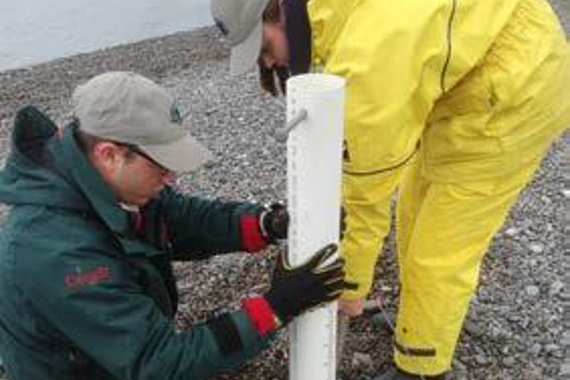
A bulldozer restoring natural grade to the Cap-des-Rosiers beach after removal of a dilapidated coastal road.
Creating resilient shorelines
Coastal restoration in Forillon National Park
What’s the issue?
 Parks Canada staff sample capelin eggs at Cap-de-Rosiers beach.
Parks Canada staff sample capelin eggs at Cap-de-Rosiers beach.The shorelines are eroding at Cap-des-Rosiers in the Gaspé Peninsula’s Forillon National Park. This unprecedented process has been aggravated by rising sea levels in the Gulf of Saint Lawrence, increased storm intensity, and a decrease in the amount protective ice in winter. As a consequence, park roads, trails and other infrastructures that are not suited to a coastal environment have begun to deteriorate, raising maintenance costs and safety concerns. Further, these environmental changes have reduced the integrity of the area’s natural and cultural features – beach habitat for spawning capelin has reduced considerably and an historic monument is at risk of being washed out to sea. In response, Forillon National Park staff set out to restore the dynamic coastal environment using ecologically sensitive and sustainable solutions.
What’s our approach?
- Collaborate with local universities and expert consultants to research strategies for adapting and restoring the coastal ecosystem of Cap-des-Rosiers.
- Re-establish native beach grasses to restore the back beach area and improve the natural resilience of the beach profile.
- Improve the quality and quantity of capelin spawning habitat on the beach.
- Safeguard the Carricks monument (commemorating the 1847 sinking of an Irish immigrant ship).
- Decommission all vulnerable infrastructure and redesign a multi-use trail for visitors between the park entrance and the Cap-des-Rosiers harbour.
- Develop and install interpretation panels for visitors to learn about the coastal restoration.
What’s been accomplished?
- Worked with the Université du Québec à Rimouski to better understand coastal erosion and develop methods for adapting to the changing Gulf of Saint Lawrence coastal dynamics.
- Dismantled 1.5 km of coastal road, public utilities and shoreline riprap; contoured beaches, creating a gradual slope and making them more resilient to winter storm surges and winds.
- Naturalized the beach front and increased capelin spawning habitat by 1.1 hectares.
- Relocated the Carricks monument to a protected inland location.
- Started construction of a multi-use trail, elevated to accommodate water fluctuations (to be completed by 2019).
- Designed interpretive panels for visitors to raise awareness about coastal dynamics and restoration (to be completed by 2019).
- Date modified :